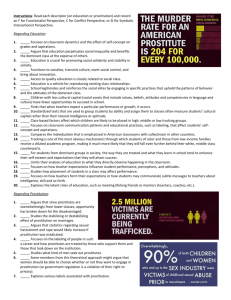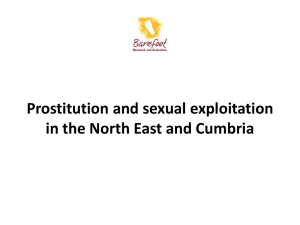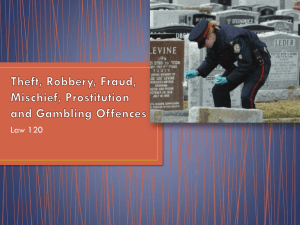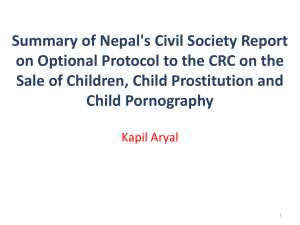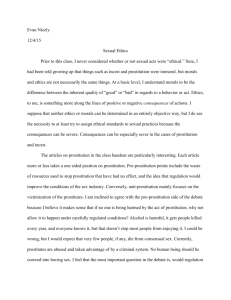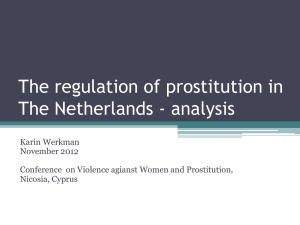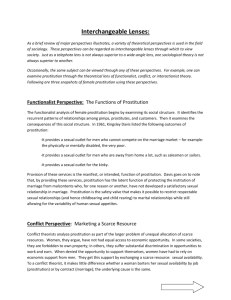Sex work, Strategy and `Community`: implications for
advertisement
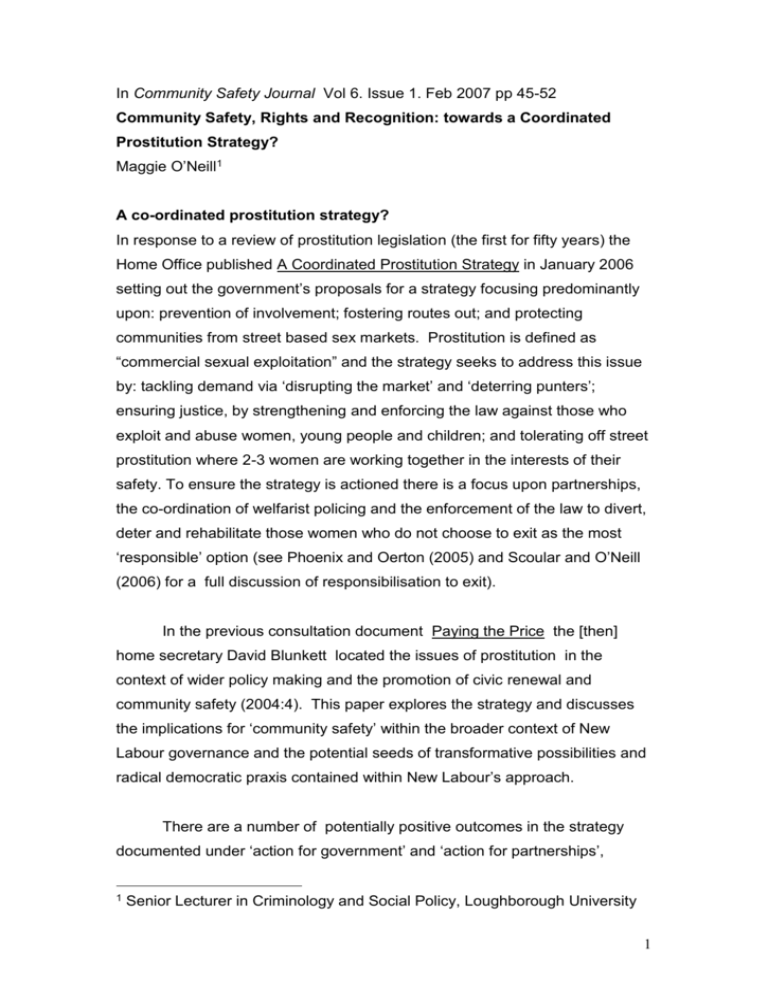
In Community Safety Journal Vol 6. Issue 1. Feb 2007 pp 45-52 Community Safety, Rights and Recognition: towards a Coordinated Prostitution Strategy? Maggie O’Neill1 A co-ordinated prostitution strategy? In response to a review of prostitution legislation (the first for fifty years) the Home Office published A Coordinated Prostitution Strategy in January 2006 setting out the government’s proposals for a strategy focusing predominantly upon: prevention of involvement; fostering routes out; and protecting communities from street based sex markets. Prostitution is defined as “commercial sexual exploitation” and the strategy seeks to address this issue by: tackling demand via ‘disrupting the market’ and ‘deterring punters’; ensuring justice, by strengthening and enforcing the law against those who exploit and abuse women, young people and children; and tolerating off street prostitution where 2-3 women are working together in the interests of their safety. To ensure the strategy is actioned there is a focus upon partnerships, the co-ordination of welfarist policing and the enforcement of the law to divert, deter and rehabilitate those women who do not choose to exit as the most ‘responsible’ option (see Phoenix and Oerton (2005) and Scoular and O’Neill (2006) for a full discussion of responsibilisation to exit). In the previous consultation document Paying the Price the [then] home secretary David Blunkett located the issues of prostitution in the context of wider policy making and the promotion of civic renewal and community safety (2004:4). This paper explores the strategy and discusses the implications for ‘community safety’ within the broader context of New Labour governance and the potential seeds of transformative possibilities and radical democratic praxis contained within New Labour’s approach. There are a number of potentially positive outcomes in the strategy documented under ‘action for government’ and ‘action for partnerships’, 1 Senior Lecturer in Criminology and Social Policy, Loughborough University 1 including the focus on strengthening approaches to child exploitation by ensuring a holistic approach that includes work with schools; including ‘communities’ through consultation processes like community conferencing; expanding court diversion and reforming the soliciting law; expanding the ugly mugs scheme through Crime Stoppers; recruiting police liaison officers and developing action planning on trafficking. And, importantly a number of critiques are emerging that seek to foster dialogue and hope to impact upon national policy making including the shape the strategy takes in action. Summarising initial critiques, the bottom line appears to be that the complexity of the issue has been missed in an attempt to protect communities, manage public space, and on the one hand regulate off street work (acknowledged as safer than street based work) whilst on the other promoting a zero tolerance approach to on street work. Also the lack of detail in the strategy leaves many unanswered questions. Melrose argues that in the process of consultation, the government appears to have given greater weight to some responses than to others, thus the ‘new’ strategy is not very new at all” and that “the government has missed an important opportunity to radically rethink its approach to prostitution (p3). Moreover, facilitating off street working by allowing in law 2-3 women (or men) to work together in the interests of safety ignores the variation in off street working, and the ensuing problems of policing such a wide range of premises, from rooms in dilapidated flats and tenements, drug dens to the “’classier’ end of the working flat market” (Melrose 2006:15). With a focus squarely upon routes out, the strategy ignores routes in and the structural basis for entry into selling sex (Melrose 2006:19). Critics also argue that the strategy ignores important health and human rights and so “will not, therefore, tackle genuine areas of vulnerability and exploitation” (Boynton and Cusik 2006:191). It is argued by Boynton and Cusik that multi-agency work by health care professionals will be disrupted if red light areas are phased out and this will increase the risks to sex workers, 2 reduce collaborative working practices, and impact on basic health and safety. Drawing on Kinnell’s research (2004) the authors state that 87 sex workers have been murdered since 1990. The endemic nature of violence against sex workers and women in general is a vital area to be taken up by the coordinated strategy and is supported by an enormous amount of research by feminists (Russell 1982, Hanmer and Saunders (1984), Kelly (1988), Hanmer, Radford and Stanko (1989), Radford (1989, 1990) and the Justice for Women collection to name but a few.) The ‘prostitutes’ status as Other, operating illegally or at the margins of legality, reinforces her ‘throwaway’ status and in relation to violence against her she is seen as a deserving victim’ ( Bland 1992, O’Neill 1994, 1996, Pearce et al 2002). This has serious implications for social policy. In the Home Office strategy, the identity of ‘the prostitute’ is fixed along a victim trajectory that ignores the wealth of research documenting the subjecthood of female and male sex workers. Thus, the prostitute identity is prioritised over other ‘ordinary’ identities such as worker, mother, sister, daughter, carer, lover, as well as structural, social and gender inequalities that lead to routes in; and this reinforces the prostitute as Other. This status as objectified Other has important consequences such as a lack of recognition and being treated as a pariah, as the end stop in discourses on good women, situated in marginal spaces and places, and a victim of male violence. Media messages provide a particularly powerful symbolic representation of the sex worker as Other that feed into the public imagination such as ‘polluting’ or ‘contaminating’ streets/areas and street sex markets are variously named as ‘capital of vice’ ‘street of shame’ and responses are named as ‘anti-vice campaigns’ or ‘police clampdowns’ (see O’Neill et al 2000). Responses to this Othering by some feminists, sex worker support projects and activists is to focus upon the recognition of women (and men) as workers, as sex workers (Bindman and Doezema 1997). The work of the UKNSWP and the GMB union serves to reinforce the basic issue that ‘prostitutes’ are ‘sex workers’ and reform should address the identity of sex workers within the context of European and International Labour law. Thus 3 sex worker rights and Unionisation are a key step on the road to recognition of the sex worker identity as worker, and thus a temporal and not a fixed identity. Unlike most citizens, the identity of the sex worker is wrapped up in what she or he does, and what she/he does becomes who she/he is regardless of whether she/he is shopping, socialising, or taking the kids to school. Claims to recognition are therefore an important aspect of work in this area over the last three decades that have been ignored by the Home Office and the Coordinated strategy. In this article, I will argue that there are two major barriers that prevent both imagining and actioning an inclusive, holistic strategy for prostitution reform in the UK that incorporates both rights and recognition (following Nancy Fraser 2000) and impacts upon perceptions of community safety. First, the image and re-presentation of ‘the prostitute’ as an Other in certain research, government policy, rhetoric, media representations and inevitably the public imagination. Related to this is the terrible reality of violence against sex workers and that this is understood and represented by some sections of the media as deserving (see Kinnell 2006). We do need to engage in a process of recognition through inclusion of sex workers and projects in research, debates and dialogue (something I have argued and practiced for almost two decades now), but we also need to address the issue of redistribution, poverty and economic routes in. Second, current responses to prostitution by the Home Office is inevitably linked to a much broader shift to intolerance and greater punitiveness in Western societies, defined by Phoenix and Oerton, as “the new moral authoritarianism” (Phoenix and Oerton 2005; Pratt 1999; Garland 2001; Scoular and O’Neill 2006; Scoular et al 2006). However, New Labour governance does, I would argue, offer both a barrier to inclusive prostitution reform and the seeds for radical reform incorporating both rights and recognition. I would like to suggest that any strategic response should focus upon the complexity of sex work in the UK in the 21st century and that 4 understanding complexity in order to improve the situation of women and men involved in selling sex be based upon the following key tenets: inclusion, rights, recognition, respect, and redistribution. To progress this vision it is important to create the space for women’s voices by using inclusive research methodologies such as participatory action research that necessarily creates safe spaces for dialogue with sex workers as well as residents in communities affected by on and off street sex work. Ultimately what I am suggesting is a politics of inclusion (following the usage of this term by Janet Newman in 2003) informed by a politics of feeling (O’Neill 2001) that brushes against the grain of the new punitiveness and moral authoritarianism, and re-connects with radical feminist perspectives on violence against women from the perspective of women’s lived experience – not government agendas and includes both rights (through redistribution) and recognition (Fraser 2000). Defining Community Safety In 2000 Rosie Campbell and myself were commissioned by Walsall South Health Action Zone to undertake a participatory action research approach to examine prostitution in Walsall. In the Walsall study Rosie and I found the following community safety concerns expressed by the sex workers we interviewed. Overwhelmingly, the pivotal issue emerging was how susceptible they are to violence from clients as well as passers-by, and how few rights they have as a ‘common prostitute’. The following three women raise similar concerns. “They think you’ve got no rights. In the papers it will say ‘a prostitute’ has been murdered. Does it matter that she’s a prostitute, she’s dead? She is a woman too.” “It was being a mum as well, I thought what would they do if I was murdered, so I came off the streets.” “9 out of 10 times you can always sus them out... dodgy punters... you might have seen them before in the area." 5 Zero tolerance of street prostitution will not address the endemic nature of violence against sex workers – it will merely remove (to a degree) it from public spaces and make it even more risky and unsafe for women who continue selling sex on street . Residents in our Walsall study focused upon the following issues with regard to community safety. A resident in focus group 5 gave a list of the concerns she had: “No safety, harassment, being asked for business, explaining things to children and making up lies to protect them. You can't walk out in a night at all now because someone might come up to you, a client or something and they might say this and that so you can’t; you don't feel safe walking anymore”. (FG5) Two other residents focused upon related aspects of community safety: “Greater feeling of intimidation and fear... they are more in our face now.” (FG6) “It has invaded our homes.” (FG6) “I think there’s more chance of…rather than violence against you yourself on the streets, there’s more chance of your home being raided, broken into in that way, than the safety aspect. I think there’s a greater degree of break-ins.” (FG4) Additionally, some residents expressed concern for the safety of sex workers. There was particular concern about vulnerable people involved in sex work and the violence they experienced from pimps and kerb-crawlers. Many residents assumed there were high levels of violence against women involved and were concerned about this. Residents made suggestions about responding to this issue that we incorporated into our recommendations. 6 A minority of the residents we interviewed were aware of the issues which lead women and young people to be involved but were so angry and frustrated by their current situation that they did not want to focus upon routes into sex work and welfare responses to prostitutes. For them to do so would serve to take the emphasis off their experiences and their feelings of being the victims of sex work ‘Community’ concerns are the focal point for the Home Office Strategy. In an attempt, in part to address ‘community’ concerns, the Home Office funded research in 2004 conducted by Hester and Westmorland. The researchers found that community mediation and liaison models could have some success in addressing community concerns. In a recent chapter (O’Neill and Campbell 2006) Rosie and I go on to argue that more constructive and inclusive consultation, including mediation and liaison models are required to develop policies and practices that may promote civic renewal and active citizenship. A good example of this is the flowering of multi-agency fora/partnership working in the 1990’s that incorporated sex worker voices through support projects as well as directly in some cases such as the pioneering POW project in Nottingham. Research I conducted using the principles of participatory action research in 1989-90 led to the setting up of an initial multi-agency forum2 that had sex workers represented alongside magistrates, police, probation, health authority, Nottingham University and Nottingham Trent University. The forum facilitated early work by POW to build bridges with the Magistrates and Police and supported the development of an Options project funded by European Social Fund monies, employing an ex sex worker and running employment and training fairs as well as providing resources for women to pay for child care and attend courses at local colleges. Resident’s representatives were invited to attend the forum but they declined. The forum was reconfigured in the mid 90’s under the combined leadership of Social Services and the Police. 2 7 A major barrier to radical change, identified by Adam Crawford, is that the current governments nostalgic appeals to homogenous notion of ‘community’ “is incongruous with the radical transformations necessary to realise modern institutions of governance through partnerships” (2001:74). As our research in Walsall highlighted, communities are not marked by homogeneity but by contingency, diversity, and a broad range of tolerance to street based sex workers exists alongside resistance and fear of crime and community safety. Participation in local governance through dialogue, a voice, to be listened to by the responsible authorities and share in locals decision making was what our resident participants wanted most. And to an extent the needs of residents (communities) is a central aspect of the HO strategy. However, as noted above sex workers are marked by their absence in the strategy document. As Others, shorn of subjecthood they are presented as victims in need of saving and responsibilising (Scoular and O’Neill 2006). Beyond Labels? The Home Office strategy effectively defines sex work as no more than a matter of violence and exploitation and ‘Community’ as something both outside the women selling sex and homogenous. The complex impact upon women’s lives of poverty, history, economics, consumerism, globalisation are negated. We need a strategy that offers fairness, equity to women, men and young people; a balanced approach based upon dialogue, communication and ultimately produced in participation with all those involved. There are no easy answers or solutions but a good place to start would be to commission research that develops the suggestions for community conferencing in the strategy and links these to research using participatory methods in order to promote the (radical) principles of progressive governance as espoused in Newman’s more optimistic version of New Labour governance. Newman identifies in New Labour’s ‘Third Way’ a significant shift from governance through hierarchy and competition to governance through networks and partnerships with an emphasis upon inclusion; and that this 8 more holistic approach to governance “results in the dissolution of old hierarchies and power blocs” (Newman 2003:3). Importantly Newman tells us that the new governance (state-society interaction) depends upon systems of co-arrangements that include costeering, collaboration, and co-operation that in turn depend upon new systems of patronage which in turn raise a number of issues. For example in seeking to ‘empower’ people or communities questions about who is and is not ‘included’ are raised and issues of tokenism and incorporation go unresolved. One way forward, for Newman, is to identify a new research agenda to explore the ‘politics of inclusion’ and exclusion in the new forms of governance, and the ‘politics of representation’ in the drive to open up decision making and stimulate democratic renewal. I suggest in a later section that participatory methodologies, including mediation and community conferencing (both the latter are included in the Home Office strategy), within the context of critical, cultural criminology using qualitative, ethnographic, action oriented research ( that has been conducted by researchers in this area for decades) provides a very good basis for fostering a radical democratic present in policy and practice that demonstrates a politics of inclusion and representation through both redistribution and recognition. As stated above, critical, cultural criminology rooted in feminist principles could move us beyond arguments for either recognition or redistribution. Creating a safe space for women’s voices as well as residents in neighbourhoods affected by sex markets to be heard and listened to through ethnographic, biographical methods is central; as is situating these voices within broader analyses of the state and what is possible in relation to policy reform. Fraser (2000) argues that currently claims for recognition (identity politics) are displacing claims for redistribution and that this has serious consequences: 9 “in so far as the politics of recognition displaces the politics of redistribution, it may actually promote economic inequality; insofar as it reifies group identities, it risks sanctioning violations of human rights and freezing the very antagonisms it purports to mediate.” (2000:108). I suggest here that the current divide between feminists who support prostitution as being abuse, exploitation and violence, a further manifestation of violence against women; and feminists who support the recognition of sex worker rights to address inequalities, violence, abuse and lack of human rights, is a clear example of too great a focus upon claims to recognition at the expense of claims for redistribution. Redistribution is displaced by identity politics (recognition claims). We need to work across this divide and challenge sexual and social inequalities with respect to both. Fraser argues that it is important to conceptualize struggles for recognition so that they can be integrated with struggles for redistribution, rather than displacing and undermining them. It also means developing an account of recognition that can accommodate the full complexity of social identities, instead of one that promotes reification and separatism. (2000:109). She goes on to suggest that instead of treating (mis) recognition through group identity (for example - sex worker or victim status) the status of the group members should be as full and equal partners in social interaction and their status not reduced to group identity. To be mis-recognised (as victim) is to be denied the status of full partner in social interaction “ unworthy of respect and esteem”(p114). In Prostitution and Feminism : towards a politics of feeling I argued for a renewed methodology for social research defined as ‘ethno-mimesis’ incorporating visual as well as ethnographic and participatory action research (PAR) methodologies to document the politics of everyday life for and with women selling sex based upon mutual recognition, respect and ultimately redistribution through action research. A politics of feeling describes the 10 process of engaging with women and their lives, from their frame of reference and through their inclusion in the research through recognition and participation. In the process we produce praxis as purposeful knowledge that may be transformative. The relationship between thinking, feeling and doing (Arendt 1979; Tester 1995) commitment and collective responsibility is central to PAR; as is the need to create the intellectual and practical spaces for women’s voices to be heard, for them to participate as equal citizens, to counter Othering, and to work towards collectively resisting and challenging sexual, social and structural inequalities. Towards a coordinated prostitution strategy? I will close with some suggestions for further discussion and debate that may point us in the direction of an effective strategy that bears reference to the wealth of data on routes in to sex work within the context of governance, Fraser’s politics of recognition and redistribution and the complex lived relations and structural/social inequalities that women experience whilst selling sex. In a recent article Jane Pitcher and myself argued, drawing upon our previous research, that it is possible to work with local residents and community groups, sex workers, sex work projects to develop an ongoing dialogue that takes into account the interests of different members of local communities, including sex workers, and ensures that the needs of sex workers are reflected in community responses to national and local policy initiatives. Moreover, that Participatory methodologies should include the voices of women, other residents and businesses and respect their expertise/experience (based upon mutual recognition). Such methodologies are also instrumental in helping to create safe spaces for these issues to be raised and dialogue to take place across the divides between – residents, responsible authorities and sex workers. Thus helping to challenge dominant discourses and hopefully feed into public policy at local, regional and national levels (O’Neill and Pitcher 2006). 11 Given the current strategy the travesty is that an already multiply disadvantaged group will be further disadvantaged and this I feel is too high a price to pay for the semblance of community safety outlined in the strategy document and needs to be addressed urgently before the impact is felt at project level (aims may shift towards prioritising exit in order to gain funding, thus the loss of much needed support services) and at grass roots level by the very women selling sex who are marginalised, stigmatised, Othered, experiencing mis-recognition. References Arendt, H (1970) On Violence New York: harcourt Brace and Co Bauman, Z ( 2000) Liquid Modernity Cambridge:Polity Bindel, J. (2004) ‘Streets Apart’, Guardian Weekend, May 15th pp. 47-55 Boynton, P and Cusik, L (2006) ‘sex Workers to pay the price’ in BMJ Vol 332, 190-191 Campbell, R and O’Neill, M (2006) Sex Work Now Cullompton, Devon:Willen Cusik, L and Berney, L (2005) ‘Prioritizing punitive responses over public health:commentary on the Home Office consultation document Paying the Price in Critical Social Policy Vol 25(4) 596-606 Fraser, N (2000) ‘Rethinking Recognitrion’ in New Left Review May/June 2000 Garland, D (2001) The Culture Of Control:crime and social order in contemporary society Oxford:Oxford University Press Hester, M.and Westmarland, N. . (2004) Tackling Street Prostitution: towards a holistic approach Home Office Research Study 279. . London: HMSO. . Home Office (2004) Paying the price: a consultation paper on prostitution. London: HMSO. Home Office (2006) A Co-ordinated Prostitution Strategy and a summary of responses to Paying the Price. London: Home Office. Kooiman, J. (1993) Modern Governance: New Government-Society Interactions. London; Newbury Park, California: Sage Publications 12 Matthews, R and Pitts, J [eds] (2001) Crime, Disorder and Community Safety London:Routledge Matthews, R. and Pitts, J, (2001) Introduction: Beyond Criminology? in R. Matthews and J. Pitts (eds), Crime, Disorder and Community Safety London: Routledge Mazo-Karras, R (1989) ‘The regulation of brothels in later Medieval England’ in SIGNS 14(3), 399-433 McLeod, E. (1982), Women Working: Prostitution Now, London: Croom Helm. Melrose et al (1999) One Way Street? Retrospectives on Childhood Prostitution, London, The Children’s Society Melrose, M (2006) ‘Trying to Make a Silk Purse from a Sow’s Ear? A Comment on the Government’s Prostitution Strategy’ in Community Safety Journal Vol. 5, No.2, pp.4-13 Newman, J. (2003) ‘New Labour, Governance and the Politics of Diversity’ in Barry, Dent and O’Neill (eds), Gender and the Public Sector: Professionals and Managerial Change London: Routledge. O’Neill, M (2001) Prostitution and Feminism:towards a politics of feeling Cambridge:Polity Press O’Neill, M and Campbell, R (2002) Working Together to Create Change Report for Walsall South Health Action Zone available on www.safetysoapbox.com O’Neill et al (2000) ‘Love for Sale: The Politics of Prostitution in Stoke’ in Edensor, T [Ed.] Reclaiming Stoke-on-Trent: Leisure, Space and Identity in the Potteries, Staffordshire: Staffordshire University Press/Trentham Books. O’Neill, M, Campbell, R, James, A, Webster, M, Green,K, Patel,J, Akhtar, N and Saleem, W (2003) in City Cultures edited by David Bell and Mark Jayne Aldershot:Ashgate O’Neill, M et al (2004) ‘New Arrivals: participatory action research, imagined communities and ‘vision’s of social justice’ in the Journal Of Social Justice Vol.32 No 1 pp75-89 O’Neill, M and Campbell, R (2006) ‘Street Sex Work and Local Communities: creating discursive spaces for genuine consultation and inclusion’ in Campbell, R and O’Neill, M [eds] Sex Work Now Cullompton:Devon O’Connell-Davidson, J ( 1998) Prostitution, Power and Freedom Cambridge:Polity Press 13 Pearce, J, Williams, M and Cristina Galvin (2002) It’s Someone Taking a Part of You: A Study of Sexual Exploitation, London: National Children’s Bureau Pheterson, G (1986) The Whore Stigma: female Dishonour and Male Unworthiness sponsored by the Dutch Ministry for Social Affairs and Employment, Emancipation Policy Coordination, the Netherlands. Phoenix, J and Oerton, S (2005) illicit and Illegal:sex, regulation and social control Cullompton, Devon:Willen Press Pitcher, J, R Campbell, P Hubbard, M O’Neill and J Scoular (2006) Living and Working in Areas of Street Sex Work: from conflict to coexistence. Bristol: Policy Press Pratt,J (1999) Sex Crime and the New Punitveness Paper presented at the History of Crime, Policing and Punishment Conference convened by the Australian Institute of Criminology in conjunction with Charles Sturt University and held in Canberra, 9-10 December 1999 Rendall, J (1997) ‘Industrious females and professional beauties, or fine articles for sale in the Burlington Arcades’ in Borden, L, Kerr, J, Pivarro, A and Rendall, J Starngely Familiar:narratives of architecture in the city London:Routledge Rickard, W (2001)’B een there, seen it, done it, got the TShirt’ in Feminist Review No 67, Spring , 111-132 Sanders, T (2005) Sex Work: A Risky Business Cullompton, Devon:Willen Scoular, J and O’Neill, M (2006) Regulating Prostitution: Social Inclusion, Responsibilisation and the Politics of Prostitution Reform paper presented at the British Criminology Society Conference, Leeds, 2006. Tester, K (1995) The Inhuman Condition london:Routledge Walkowitz, J (1980) prostitution and Victorian Society Cambridge:Cambridge University Press 14

